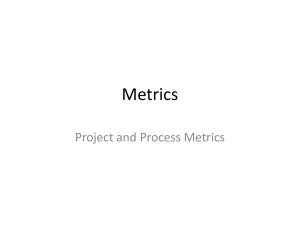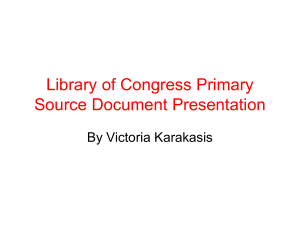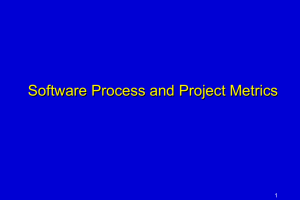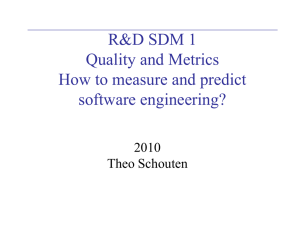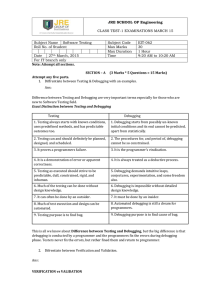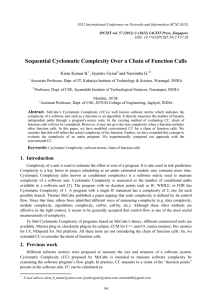Software Metric
advertisement
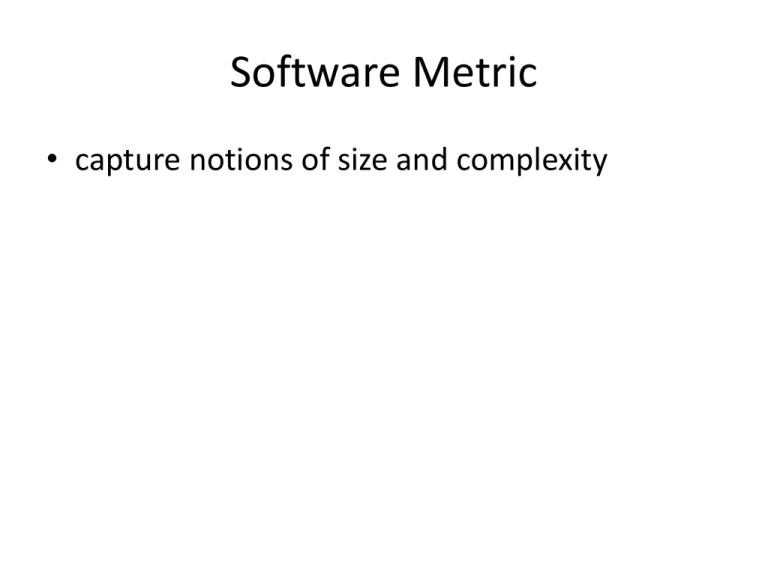
Software Metric • capture notions of size and complexity Size metrics • Ideally, we want to define a set of attributes for software size analogous to human height and weight. That is, we want them to be fundamental so that each attribute captures a key aspect of software size – Length (LOC) – Functionality – Complexity LOC • The most commonly used size indicator. • Issues: – How to define LOC? – How to know LOC before any coding? – How to interpret LOC? (is 250 more productive than 200?) • What about different programming languages? Lines of Code Calculation •What can be consideredas a line? • statement • data definition • comments? • Line ≠ debug code? • Different languages? Assembly and Java Scaling factor Beta Distribution Measurement • Ask developers for the following LOC values: • Optimistic (O) • Pessimistic (P) • Realistic (R) LOC = (O+P+4*R)/6 • E.g., R=250, O=200, P=400 => LOC=266 The Blitz • Based on historical observation of previous projects. LOC = Processes x prgs/processes x avg. prg size • Process = class, db table, … • E.g., 20 classes, 1 program/class, 50 Java LOC/prg => LOC = 20*1*50 = 1000 Functionality • Many software engineers argue that length is misleading and that the amount of functionality in an inherent product paints a better picture of product size • In particular, those who generate effort and duration estimates from early development often prefer to estimate functionality rather than physical size Function points (FP) • Uses the functionality of the software as a measure • Analogy: For a given house, we can say how many square meters it has (LOC) or we can say how many bedrooms and bathrooms it has (FP). • The idea was first put forward by Allan Albrecht of IBM in 1979. Function points (FP) • Derived using an empirical relationship based on countable (direct) measures of software’s information domain (i.e., things in the external behavior that will require processing) • A function point count is a measure of the amount of functionality in a product • Can be estimated early in project before a lot is known Information domain values • Number of external inputs (EI) – Originates from a user or is transmitted from another application and provides distinct application-oriented data or control information • Number of external outputs (EO) – Derived within the application and provides information to the user • Number of external inquiries (EQ) – Interactive inputs requiring a response Information domain values • Number of internal logical files (ILF) – A logical grouping of data that resides within the application’s boundary and is maintained via external inputs • Number of external interface files (EIF) – A logical grouping of data that resides external to the application but provides data that may be of use to the application Computing function points: step 1 • Establish count for information domain values • Number of external inputs • Number of external outputs • Number of external inquiries • Number of internal logical files • Number of external interface files Computing function points: step 2 • Associate complexity value with each count • Simple, Average, Complex • Determined based on organisational experience based criteria. Nonetheless, the determination of complexity is somewhat subjective • Compute count total Computing function points: step 2 Computing function points: step 3 • Calculate complexity adjustment values (Fi, where i[1..14]) • • • • • Does the system require reliable backup and recovery? Are data communications required? Are there distributed processing functions? Is performance critical? Will the system run in an existing, heavily utilised operating environment? • Does the system require on-line data entry? Computing function points: step 3 • Does the on-line data entry require the input transaction to be built over multiple screens or operations? • Are the master files updated on-line? • Are the inputs, outputs, files or inquiries complex? • Is the internal processing complex? • Is the code designed to be reusable? • Are conversion and installation included in the design? • Is the system designed for multiple installations in different organisations? • Is the application designed to facilitate change and ease of use by the user? Computing function points: step 3 • Answer each question using a scale of 0 (N/A) to 5 (absolutely essential) • Sum the 14 complexity adjustment values SFi Computing function points: step 4 • Calculate FP = count total ´ (0.65 + 0.01´Fi) • 0.65 and 0.01 are empirically derived constants Function point (FP): Advantages • Programming language independent • Used readily countable characteristics that are determined early in the software process • Does not “penalize” inventive (short) implementations that use fewer LOC than other more clumsy versions Comparing LOC and FP Programming Language LOC per Function point avg. median low high Ada Assembler C C++ COBOL 154 337 162 66 77 315 109 53 77 104 91 33 29 14 Java JavaScript Perl PL/1 Powerbuilder SAS Smalltalk SQL 63 58 60 78 32 40 26 40 53 63 67 31 41 19 37 77 42 22 11 33 10 7 - Visual Basic 47 42 16 158 Rough Estimates 205 694 704 178 400 75 263 105 49 55 110 LOC and FP • LOC and FP-based metrics have been found to be relatively accurate predictors of software development effort and cost • Typical metrics – $ per LOC, $ per FP – LOC per person-month, FP per person-month – errors per KLOC, errors per FP – pages of documentation per KLOC, pages of documentation per FP Complexity metrics • Numerous metrics have been proposed for measuring program complexity – probably more than for any other program characteristic • Complexity can be interpreted in different ways, depending on our perspective – Problem complexity (also called computational complexity) measures the complexity of the underlying problem – Algorithmic complexity reflects the complexity of the algorithm implemented to solve the problem – Structural complexity measures the structure of the software used to implement the algorithm – Cognitive complexity measures the effort required to understand the software Complexity metrics • Numerous metrics have been proposed for measuring program complexity – probably more than for any other program characteristic • Complexity can be interpreted in different ways, depending on our perspective – Problem complexity (also called computational complexity) measures the complexity of the underlying problem – Algorithmic complexity reflects the complexity of the algorithm implemented to solve the problem – Structural complexity measures the structure of the software used to implement the algorithm – Cognitive complexity measures the effort required to understand the software Complexity metrics • Our intuition tells us that the complexity of a program can affect the time it takes to code it, test it, and fix it • We suspect that complexity can help us to understand when a module is prone to contain faults • We often assume that we know what complexity is, and we measure complexity without first defining it in the real world • Many software developers define program complexity as the cyclomatic number proposed by McCabe Cyclomatic complexity • Cyclomatic complexity is a software metric that provides a quantitative measure of the logical complexity of a program • It was proposed by Tom McCabe in 1976 • This number, based on a graph-theoretic concept, counts the number of linearly independent paths through a program (we have seen this in the context of testing with basis path testing) • McCabe felt that the number of such paths was a key indicator not just of testability but also of complexity Cyclomatic complexity • A number of industry studies have indicated that the higher the cyclomatic complexity of a module is, the higher the probability of errors • In one experiment, modules with cyclomatic complexity > 10 were shown to have statistically more errors • If there are lots of modules to test and it is not feasible to test all of them, concentrate on the ones with highest cyclomatic complexity values, they are the ones that are most likely to be error prone Cyclomatic complexity: actual cases • [Grady, 1994] reported a study at HewlettPackard where cyclomatic number was computed for each module of 850,000 lines of FORTRAN code • A close relationship between a module’s cyclomatic complexity number and the number of updates required was discovered • The study team concluded that 15 should be the maximum cyclomatic number allowed in a module Cyclomatic complexity: actual cases • The quality assurance procedure for the software in the Channel Tunnel rail requires that a module be rejected if its cyclomatic number is greater than 20, or if it has more than 50 statements [Bennett, 1994] Cyclomatic complexity • The cyclomatic number presents only a partial view of complexity – There are many programs that have a large number of decisions but are easy to understand, code, and maintain – Relying only on the cyclomatic number to measure actual program complexity can be misleading Current state of software metrics • Even in the case of widely studied metrics (e.g., LOC, Halstead’s metrics, McCabe’s cyclomatic complexity), not universally agreed what they measure • Difficult to interpret and compare quoted metric results. For example, if different programming languages are involved, metrics involving LOC values can, if not carefully interpreted lead to incorrect conclusions – Do you see any problem(s) with LOC/month as a productivity measure? • Could suggest that assembly language programmers are more productive than high-level language programmers • Despite these problems, if properly used, many software metrics can lead to very useful results
